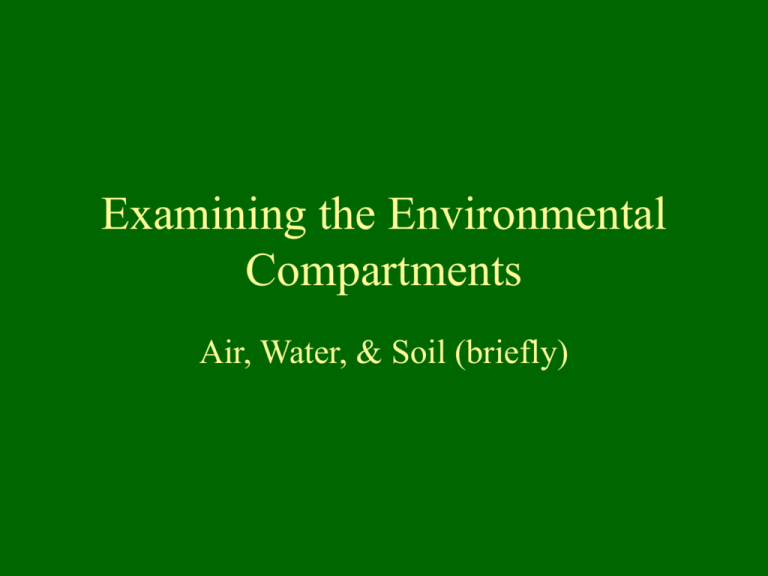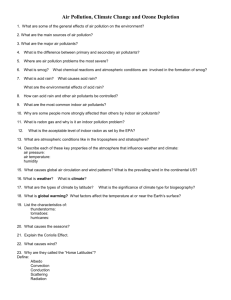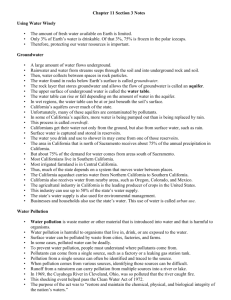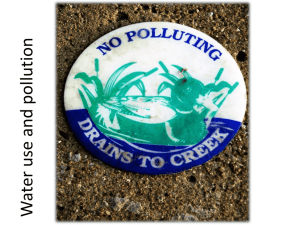Examining the Environmental Compartments
advertisement

Examining the Environmental Compartments Air, Water, & Soil (briefly) Air Pollution • The accumulation of substances in the atmosphere that can cause harmful health effects to living things or negatively affect the public welfare • Economic impact of property or crop damage Human Activity • • • • Transportation Power and heat generation Industrial processes Burning of solid waste Natural Processes • Volcanic eruptions • Natural forest fires Air pollution laws To control smoke emissions • 1880’s – Chicago and Cincinnati • 1890’s – Pittsburgh and New York City Number of days in a 5-yr period characterized by poor air circulation, for at least a 48-hr period. Killer Fogs • Donora, Pennsylvania - 1948 • London, England – 1952 • Caused the death of thousands and the illness of tens of thousands • Oregon - 1952 • Became the first state to pass air pollution control legislation and establish a state air pollution control agency Health problems brought on or aggravated by air pollution • Lung diseases, such as chronic bronchitis and emphysema • Cancer, particularly lung cancer • Neural disorders, including brain damage • Bronchial asthma and the common cold • Eye irritation • Those most sensitive: – Young children whose respiratory systems are still forming – People who suffer from diseases of the heart and respiratory system Modern Smog • No longer smoke and soot • Photochemical reactions & electrical motors produce ozone • Very reactive, breaking down biological tissues and cells • Damages crops and vegetation, buildings and art treasures Precursors to this reaction • Volatile Organic Compounds or VOC’s created in the combustion, handling and processing of petroleum products • Nitrogen Oxides or NOx produced by combustion • Levels are highest during summer daytime hours California’s Distinctions • Most severe air quality problem • Most advanced air pollution controls • ¾ of the country’s health problems from air pollution are in So. California Common Air Pollutants – Fig 5.5 Table of Pollutants & Health Concerns • • • • • • Carbon monoxide Airborne particulates Sulfur dioxide Lead Nitrogen oxides Asbestos • • • • • • Beryllium Vinyl chloride Mercury Arsenic Benzene Radionuclides National Ambient Air Quality Standards - NAAQS • Enforced by the EPA under the authority of the Clean Air Act to reduce outdoor pollution • Identifies safe levels of CO, Pb, NOx, O3, SO2, and particulates – the criteria pollutants • Can pose sanctions on areas that are in nonattainment Smog and Crops • California’s agricultural industry is losing $300 million each year to air pollution • Also damages forests, range and pasture land • California's geography and climate coupled with population growth and dependence on cars Harm to native plant groups • Needles and debris from trees killed by smog increases the risk of forest fires, reduces seed germination and seedling survival • At a reproductive disadvantage, these plants may be replaced by new plant communities completely altering the food chains within the ecosystem Sources and fate of air pollutants • Primary pollutants enter the air directly – Oxides of carbon and nitrogen and hydrocarbons from vehicle emissions – Sulfur oxides and particulates from industry • Secondary pollutants form from another substance that was released into the air – Ozone Indoor air pollution • The most people spend 90% of their time indoors • New buildings are tightly constructed to save energy (ex. Radon) • Up to 30% of new and remodeled buildings may have air quality problems • • • • • • • • Eye, nose and throat irritation Fatigue Headache Nausea Irritability Forgetfulness Impairment of the nervous system Cancer Sources of indoor pollutants • • • • • • • • • Tobacco smoke Building materials Furnishings Space heaters Gas ranges Wood preservatives Air fresheners Solvents Cleaning agents New Section: Water Pollution • Over 17% of the nation’s waterways are significantly polluted • 10% of all medium and large sized public water systems exceed health based limits for lead • Wetlands are being destroyed at a rate of between 350,000 and 500,000 acres per year Threats to clean water • Applications of pesticides and fertilizers • Uncontrolled hazardous waste disposal • Leaking underground storage tanks • Use of septic tanks and drainage wells Global Perspective • The average American uses 180 gallons of fresh clean water a day • Rural villagers in third world countries may spend up to 6 hours a day obtaining a supply of tainted water • 10 million people die every year of intestinal diseases Four major categories • • • • Municipal (Class provide examples) Industrial (Class provide examples) Nonpoint Dredge and fill activities Nonpoint Sources • • • • Run off from farming Urban areas Forestry Construction activities • Contribute up to 75% of the contamination in rivers and streams Dredging • Stirs up bottom sediments re-exposing PCB’s and heavy metals • Where sediment is piled on shore it may harm sensitive wetlands Groundwater • Half of Americans and 95% of rural Americans use groundwater • From 1950-1960 groundwater use has increased by 150% Sources of Groundwater Contamination • • • • • • • Septic tanks Underground storage tanks Agricultural activities On-site landfills Surface impoundments Municipal landfills Abandoned waste sites • • • • • • • • Oil and gas brine pits Saltwater intrusion Road salting Land application of sludge Regulated waste sites Mining activities Underground injection wells Construction activities Key Terms • Aquifer - water bearer, stores and transmits water • Aquitard - confining bed • Vadose Zone - unsaturated zone • Saturated Zone - phreatic zone • Water Table – piezometric surface • Porosity – the volume of space between particles within a substance • Permeability – how easily water can pass through (hydraulic conductivity) • Artesian aquifers – confined aquifer • Groundwater gradient – drop in elevation of water table, divided by the distance Soils & Contaminants • Soils is a connection between water (groundwater) and the atmosphere • Soil is created from weathered rock and is a complex mixture of materials • We’ll be covering these materials in detail in lab








